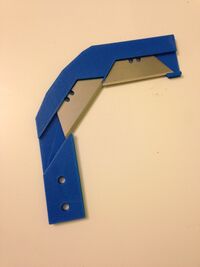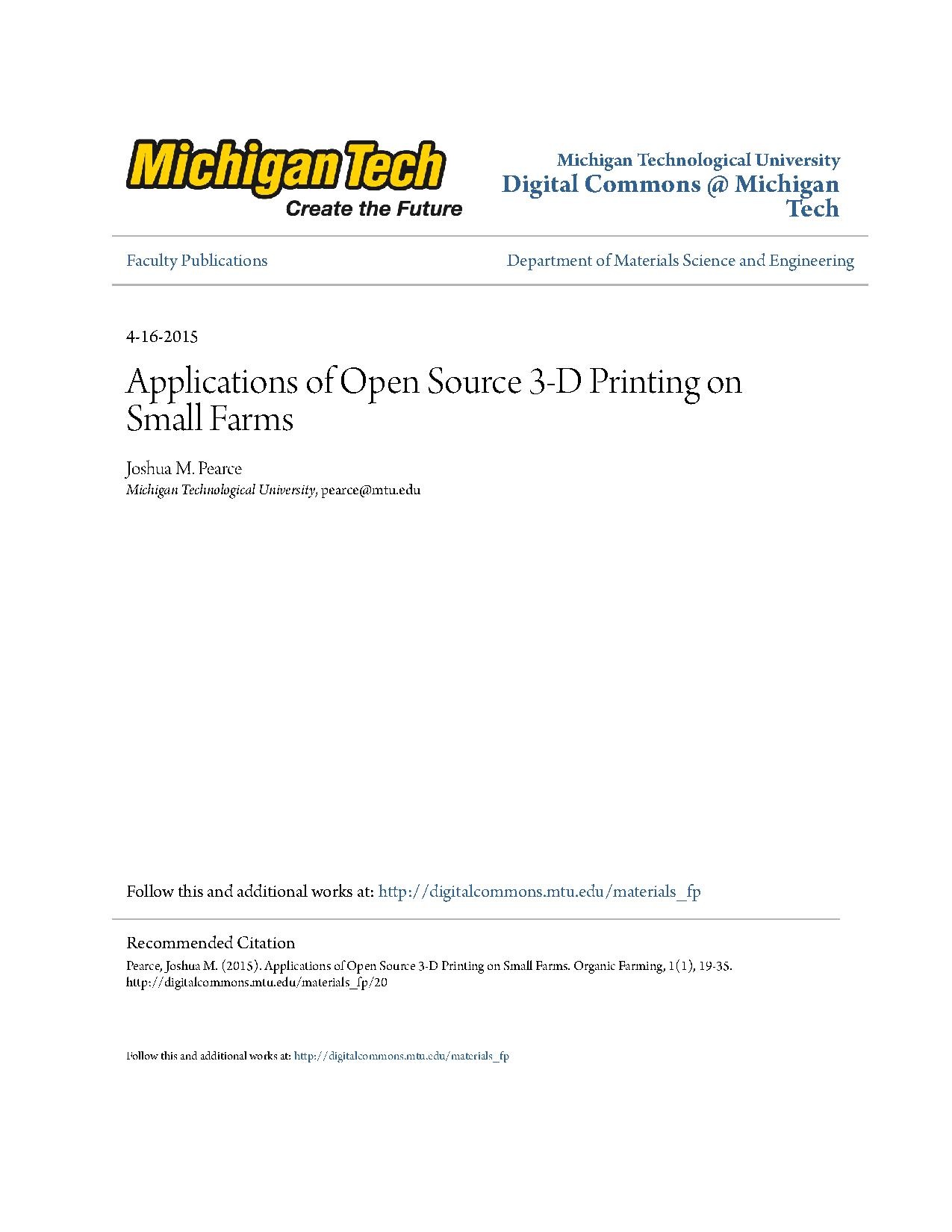(Adding relevant category) |
|||
| (23 intermediate revisions by one other user not shown) | |||
| Line 8: | Line 8: | ||
==Abstract== | ==Abstract== | ||
Pruning hooks are usually used to cut branches down from trees, but in Ghana pruning hooks are used to cut down cocoa pods from tall trees. The pruning hook saves time so the farmers do not have to climb the trees with machetes. This 3D printed pruning hook is meant to be attached to the end of a long wooden pole. That means the length of the pruning hook can change by switching out the attachment with different sized poles. | |||
[[Image:pruning hook.jpeg|200px|right]] | |||
== Bill of Materials== | == Bill of Materials== | ||
# | # (15 grams) Filament | ||
# | # (2) Stanley Heavy Duty Utility Blades (50 for $9.58) http://www.amazon.com/gp/product/B0006HVTSO?keywords=heavy%20duty%20razor%20blades&qid=1449560989&ref_=sr_1_2&sr=8-2 | ||
# | # (4) 3MM nuts and bolts | ||
# (2) 6MM wood screws | |||
The STL file for the part and openSCAD file can be found here: | |||
*[[File:pruning_hook.scad]] | |||
*[[File:pruning_hook.stl]] | |||
Original File which was referenced | |||
*[[File:OSAT2.scad]] | |||
== Tools needed for fabrication of the OSAT== | == Tools needed for fabrication of the OSAT== | ||
| Line 20: | Line 29: | ||
== Skills and Knowledge Necessary to Make the OSAT == | == Skills and Knowledge Necessary to Make the OSAT == | ||
* | * Knowledge of OpenSCAD | ||
* Tolerancing | |||
== Technical Specifications and Assembly Instructions== | == Technical Specifications and Assembly Instructions== | ||
# | # Download the STL file from above (Bill of Materials, pruning-hook.stl) | ||
# | # Convert the STL to a gcode file using Cura | ||
# | # Upload the gcode file to Repetier Server and print the part (depending on the settings in Cura the print should take about an hour) | ||
# | # Once the part has finished parting remove it from the bed | ||
# | # Take two razor blades and insert them into the two slots lining them up with the 3MM holes | ||
# Use the 3MM bolts and nuts to secure the razor blades in place (if necessary ream out the holes with a 3MM drill bit) | |||
# Laslty attach the pruning hook end to the end of any wooden pole with the 6MM wood screws | |||
=== Common Problems and Solutions=== | === Common Problems and Solutions=== | ||
* | * Be careful when inserting the sharp razor blades | ||
* The fit between the slot and the blades is very tight you may need to use an X-acto knife to clean it up before inserting the razor blades | |||
== Cost savings== | == Cost savings== | ||
* | * Estimated cost: $1.16 ($0.43 filament, $0.40 razor blades, $0.32 nuts and bolts) | ||
* Commercial Equivalent: $45 | |||
http://www.amazon.com/COUNCIL-640C-Ditch-Bank-Blade/dp/B00002NBQ8/ref=pd_sim_sbs_86_1?ie=UTF8&dpID=31F95Y39VVL&dpSrc=sims&preST=_AC_UL160_SR95%2C160_&refRID=07D98TPNA7AN6508XE6Q | |||
* Estimated cost savings: $43.84 | |||
==References== | ==References== | ||
<ref> Web page: Appropedia, Field Dressing Tool (2014) Available: http://www.appropedia.org/Field_Dressing_Tool</ref> <ref> Article: Michigan Techonological University, Applications of Open Source 3-D Printing on Small Farms (2015) Available: [[File:Applications of Open Source 3-D Printing on Small Farms.pdf]] </ref> | |||
< | |||
[[Category:How tos]] | [[Category:How tos]] | ||
[[Category: | [[Category:Food]] | ||
[[Category: | [[Category:Farming]] | ||
[[Category:Gardening tools]] | |||
[[category:OSAT 3D-Printable Designs]] | [[category:OSAT 3D-Printable Designs]] | ||
Revision as of 08:43, 10 February 2017
Pruning Hook End
Project developed by Hannah Powers
Template:Statusboxtop Template:Status-design Template:Status-prototype You can help Appropedia by contributing to the next step in this OSAT's status. Template:Boxbottom
Abstract
Pruning hooks are usually used to cut branches down from trees, but in Ghana pruning hooks are used to cut down cocoa pods from tall trees. The pruning hook saves time so the farmers do not have to climb the trees with machetes. This 3D printed pruning hook is meant to be attached to the end of a long wooden pole. That means the length of the pruning hook can change by switching out the attachment with different sized poles.

Bill of Materials
- (15 grams) Filament
- (2) Stanley Heavy Duty Utility Blades (50 for $9.58) http://www.amazon.com/gp/product/B0006HVTSO?keywords=heavy%20duty%20razor%20blades&qid=1449560989&ref_=sr_1_2&sr=8-2
- (4) 3MM nuts and bolts
- (2) 6MM wood screws
The STL file for the part and openSCAD file can be found here:
Original File which was referenced
Tools needed for fabrication of the OSAT
MOST Delta RepRap or similar RepRap 3-D printer
Skills and Knowledge Necessary to Make the OSAT
- Knowledge of OpenSCAD
- Tolerancing
Technical Specifications and Assembly Instructions
- Download the STL file from above (Bill of Materials, pruning-hook.stl)
- Convert the STL to a gcode file using Cura
- Upload the gcode file to Repetier Server and print the part (depending on the settings in Cura the print should take about an hour)
- Once the part has finished parting remove it from the bed
- Take two razor blades and insert them into the two slots lining them up with the 3MM holes
- Use the 3MM bolts and nuts to secure the razor blades in place (if necessary ream out the holes with a 3MM drill bit)
- Laslty attach the pruning hook end to the end of any wooden pole with the 6MM wood screws
Common Problems and Solutions
- Be careful when inserting the sharp razor blades
- The fit between the slot and the blades is very tight you may need to use an X-acto knife to clean it up before inserting the razor blades
Cost savings
- Estimated cost: $1.16 ($0.43 filament, $0.40 razor blades, $0.32 nuts and bolts)
- Commercial Equivalent: $45
- Estimated cost savings: $43.84
References
- ↑ Web page: Appropedia, Field Dressing Tool (2014) Available: http://www.appropedia.org/Field_Dressing_Tool
- ↑ Article: Michigan Techonological University, Applications of Open Source 3-D Printing on Small Farms (2015) Available:
